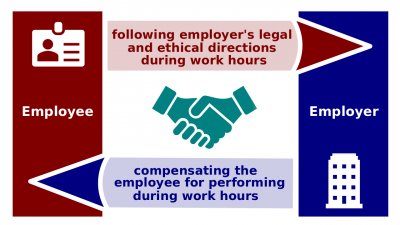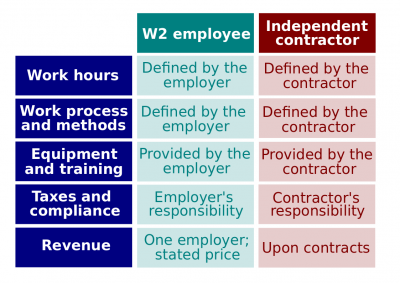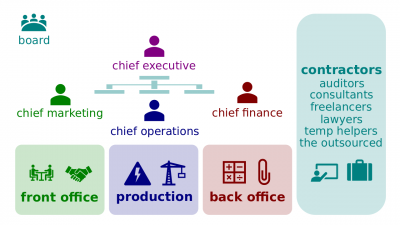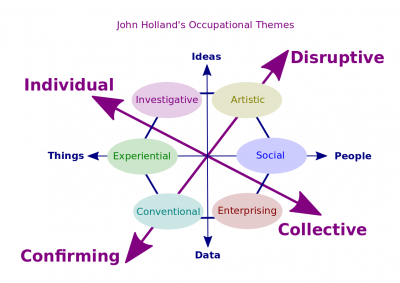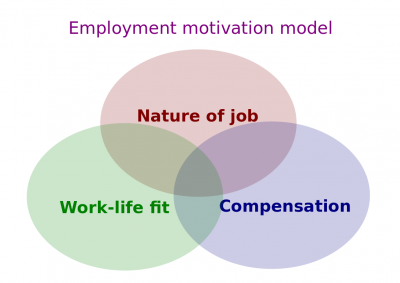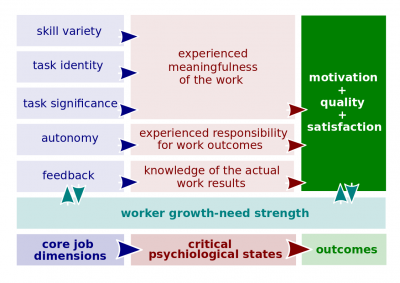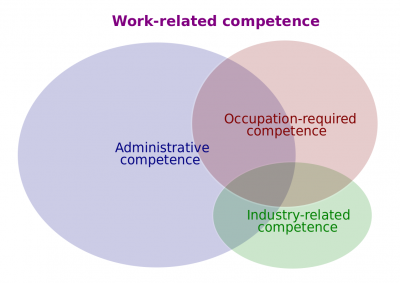Difference between revisions of "Book of Employment"
(→Employment Essentials) |
(→Nature of Occupations) |
||
| Line 60: | Line 60: | ||
:''Main wikipage: [[Nature of Occupations]]; [https://youtu.be/bVNQOFVsPyQ video (6:09)]'' | :''Main wikipage: [[Nature of Occupations]]; [https://youtu.be/bVNQOFVsPyQ video (6:09)]'' | ||
| − | :'''[[Occupation]]'''. The regular activity that a person undertakes in order to earn his or her livelihood. That activity can be a job, profession, or position that somebody works in. Entrepreneurs may refer their [[occupation]] as [[self-employed]]. | + | :'''[[Occupation]]'''. The regular activity that a person undertakes in order to earn his or her livelihood. That activity can be a job, profession, or position that somebody works in. Entrepreneurs may refer their [[occupation]] as [[self-employed]].<div style="background-color:#efefef; padding: 5px; margin: 15px;"> |
| + | :*'''[[Occupational Outlook Handbook]]'''. | ||
| + | :*'''[[Occupational Information Network]]'''.</div> | ||
| + | :'''[[Occupation list]]. Any attempt to classify various [[occupation]]s. No one can be considered 'compete' or 'final.'<div style="background-color:#efefef; padding: 5px; margin: 15px;"> | ||
:*'''[[Artisan]]'''. | :*'''[[Artisan]]'''. | ||
:*'''[[Assistant]]'''. | :*'''[[Assistant]]'''. | ||
Revision as of 22:55, 18 November 2019
Introduction to Employment (hereinafter, the Session) is a learning session introducing its participants to employment and related topics. The Session consists of six presentations, each of which is followed by a quiz. The official version of the Session is published at CNM Certs. Its materials are also published at CNM Pages, CNM Wikis, and various channels for marketing and convenience purposes.
The Session is the second of eight sessions of both CNM Digital Orientation and WorldOpp Orientation.
Contents
Outline
In the WorldOpp Orientation, the Welcome to Friends Of CNM is the predecessor session. So is the Welcome to CNM in the CNM Digital Orientation.
Employment Essentials
- Main wikipage: Employment Essentials; video (9:35)
- Employment. In the workspace, employment is an agreement between an employer, who agrees to compensate an employee in exchange for his or her work time, and an employee, who agrees to follow the employer's directions during work hours in exchange for the employer's compensation, as well as a process and/or result of that exchange.
- Worktime seller. Any individual who is in a business of selling his or her work time to employers. The sellers include employees, employment candidates, and pretty much every seller on the job market.
- Employee. Any individual employed by an employer for some compensation that most likely includes wages or a salary.
- Independent contractor. An individual or another legal entity that provides goods or services to another entity under terms specified in a contract or within a verbal agreement. Unlike an employee, an independent contractor does not work regularly for an employer, but works as and when required, during which time he or she may be subject to law of agency. Independent contractors are usually paid on a freelance basis. Contractors often work through a limited company or franchise, which they themselves own, or may work through an umbrella organization.
- Self-employed. The state of working for oneself as a freelance or the owner of a business rather than for an employer.
- Apprentice. Any employee who is not fully qualified to perform his or her workload, but agreed to work usually for a part of the fully-skilled worker compensation under the condition of educational assistance in order to gain the needed work-related competence.
- Volunteer. A person who does something, especially helping other people, willingly and without being forced or paid to do it.
- Employment candidate. Any candidate in a search for employment as an employee.
- Intern. A student in some professional field or recent graduate from an educational program gaining supervised practical experience in the workplace.
- Paid intern. An intern who is compensated for his or her work time at a regular employee level or some percentage of a regular employee compensation.
- Unpaid intern. An intern who is not compensated for his or her work time.
Industries and Specialties
- Main wikipage: Industries and Specialties
- Industry. Any part of an economy, a group of enterprises, that creates a particular type of products.
- Industrial classification.
- Raw materials industry. The industry that groups those enterprises that create raw materials or those substances that the manufacturing industry processed in order to create goods.
- Infrastructure industry. The industry that groups those enterprises that supply and present all substances, materials, and properties such as energy, water, buildings, and roads that human beings, other entities, and their equipment are needed in order to function, as well as utilize the processed substances, materials, and properties. This industry includes both construction and utility enterprises.
- Manufacturing industry. The industry that groups those enterprises that .
- Transportation industry. The industry that groups those enterprises that .
- Digital industry. The industry that groups those enterprises that .
- Market exchange industry. The industry that groups those enterprises that .
- Enterprise support industry. The industry that groups those enterprises that .
- Public service industry. The industry that groups those enterprises that .
- Healthcare industry. The industry that groups those enterprises that .
- Human development industry. The industry that groups those enterprises that .
- Live-sustaining industry.
- Professional specialty.
- Arts specialty. The professional specialty that .
- Finance specialty. The professional specialty that .
- Health specialty. The professional specialty that .
- Human development specialty. The professional specialty that .
- Information specialty. The professional specialty that .
- Law specialty. The professional specialty that .
- Marketplace specialty. The professional specialty that .
- Media specialty. The professional specialty that .
- Project specialty. The professional specialty that .
- Property administration specialty. The professional specialty that .
- Research specialty. The professional specialty that .
Nature of Occupations
- Main wikipage: Nature of Occupations; video (6:09)
- Occupation. The regular activity that a person undertakes in order to earn his or her livelihood. That activity can be a job, profession, or position that somebody works in. Entrepreneurs may refer their occupation as self-employed.
- Occupation list. Any attempt to classify various occupations. No one can be considered 'compete' or 'final.'
- Holland Occupational Themes.
- Experiential occupation (realistic occupation, motoric occupation). An occupation that frequently involves work activities that include practical, hands-on problems and solutions. They often deal with plants, animals, and real-world materials like wood, tools, and machinery. Many of the occupations require working outside, and do not involve a lot of paperwork or working closely with others. Examples of that type of occupations may include a carpenter, engineer, farmer, and tester. Collectively, they may be called "doers;" in ancient times, they would have been hunters.
- Investigative occupation (intellectual occupation). An occupation that frequently involves working with ideas and requires an extensive amount of thinking. These occupations can involve searching for facts and figuring out problems mentally. Examples of that type of occupations may include an auditor, business analyst, compliance officer, cost estimator, editor, inspector, interviewer, and lawyer. Collectively, they may be called "thinkers;" in ancient times, they would have been shamans.
- Artistic occupation (esthetic occupation). An occupation that frequently involves working with forms, designs and patterns. They often require self-expression and the work can be done without following a clear set of rules. Examples of that type of occupations may include an artist, composer, designer, enterprise architect, and creative writer. Collectively, they may be called "innovators;" in ancient times, they would have been artisans.
- Social occupation (supportive occupation). An occupation that frequently involves working with, communicating with, and teaching people. These occupations often involve helping or providing service to others. Examples of that type of occupations may include a career counselor, job coach, mediator, sales representative, and teacher. Collectively, they may be called "helpers;" in ancient times, they would have been healers.
- Enterprising occupation (persuasive occupation). An occupation that frequently involves starting up and carrying out projects. These occupations can involve leading people and making many decisions. Sometimes they require risk taking and often deal with business. Examples of that type of occupations may include an architect, product owner, and self-employed. Collectively, they may be called "creators;" in ancient times, they would have been leaders.
- Conventional occupation (conforming occupation). An occupation that frequently involves following set procedures and routines. These occupations can include working with data and details more than with ideas. Usually there is a clear line of authority to follow. Examples of that type of occupations may include an accountant, administrative assistant, bookkeeper, document management specialist, and technical writer. Collectively, they may be called "organizers;" in ancient times, they would have been guardians.
Work Environments
- Main wikipage: Work Environments; video (5:29)
- Employment motivation model. A framework for analyzing employment motivation that identifies three domains that contribute to the motivation to work. These domains include job itself, its compensation, and its fit to one's life.
- Employee compensation. The cash compensation and employee benefits that an employee receives in exchange for the service he or she performs for their employer and/or for his or her time.
- Job characteristics model. A framework for analyzing and designing jobs that identifies five core job dimensions, their interrelationships, and their impact on outcomes. These core job dimensions include skill variety, task identity, task significance, autonomy, and feedback.
- Skill variety. The degree to which a job requires a variety of activities so that an employee can use a number of different skills and talents.
- Task identity. The degree to which a job requires completion of a whole and identifiable piece of work.
- Task significance. The degree to which a job has a substantial impact on the lives or work of other people.
- Autonomy. The degree to which a job provides substantial freedom, independence, and discretion to the individual in scheduling work and determining the procedures to be used in carrying it out.
- Feedback. The degree to which carrying out the work activities required by a job results in the individual obtaining direct and clear information about the effectiveness of his or her performance.
- Task structure. A set of structural job characteristics with which the worker interacts.
- Consequence of error. How serious would the result usually be if the worker made a mistake that was not readily correctable?
- Degree of automation. How automated is the job?
- Freedom to make decisions. How much decision making freedom, without supervision, does the job offer?
- Frequency of decision-making. How frequently is the worker required to make decisions that affect other people, the financial resources, and/or the image and reputation of the organization?
- Impact on enterprise. What results do your decisions usually have on other people or the image or reputation or financial resources of your employer?
- Importance of being exact (or accurate). How important is being very exact or highly accurate in performing this job?
- Importance of repeating same tasks. How important is repeating the same physical activities (e.g., key entry) or mental activities (e.g., checking entries in a ledger) over and over, without stopping, to performing this job?
- Level of competition. To what extent does this job require the worker to compete or to be aware of competitive pressures?
- Structured versus unstructured work. To what extent is this job structured for the worker, rather than allowing the worker to determine tasks, priorities, and goals?
- Time pressure. How often does this job require the worker to meet strict deadlines? How important is it to this job that the pace is determined by the speed of equipment or machinery? (This does not refer to keeping busy at all times on this job.)
- Work schedule. How regular are the work schedules for this job and what is the number of hours typically worked in one week?
- Work virtualization. The degree to which work is done remotely rather than at some specific physical location.
- Cash compensation.
- Employee benefit.
Work Competences
- Main wikipage: Work Competences; video (3:49)
- Work-related competence. Competence needed to perform productively in a particular occupation and, often, in a particular industry.
- Occupation-required competence. Competence required for a particular occupation.
- Industry-related competence. Competence related to work in a particular industry.
- Administrative competence. Competence needed to undertake enterprise efforts conceptually, regardless of specific industry or occupation.
- Operational competence (technical competence, technical skills). Knowledge, skills, and abilities needed to perform the most of jobs. That competence includes capacity to read, write, analyze, use computers, etc.
- Interpersonal competence (human competence, interpersonal skills, people skills). Knowledge, skills, and abilities needed to work with other people individually and in a group. That competence includes capacity to listen actively, communicate, understand other's motivation, etc.
- Enterprise competence (organizational competence, organizational skills, conceptual competence). Knowledge, skills, and abilities needed to undertake enterprise efforts as well as to work in and with enterprises. That competence includes capacity to navigate organizations and bureaucracies, plan resources, research for and execute regulatory compliance, etc.
Labor Regulations
- Main wikipage: Labor Regulations
- Labor law (labour law, employment law). A set of government rules that regulate relationships between employees, employers, trade unions and the government. Government agencies usually enforce that set of laws.
- National Labor Relations Act (Wagner Act). The cornerstone of U.S. Federal labor law. The act was the first in history to give most private sector employees the right to organize into unions, to bargain collectively with employers, to define unfair labor practices by employers, and to create the NLRB.
- Fair Labor Standards Act (FLSA). The labor law that requires employers to pay covered employees at least the federal minimum wage and overtime pay of one-and-one-half-times the regular rate of pay for work exceeding a 40-hour week.
- Civil Rights Act.
- Occupational Safety and Health Act (OSH Act). The labor law that encourages safer workplace conditions in the United States. This law established the federal Occupational Safety and Health Administration (OSHA) to set standards and perform inspections at job sites. In some states, an OSHA-approved state agency helps enforce job safety standards, which must be at least as stringent as federal guidelines.
- Americans with Disabilities Act (ADA).
Introduction to Recruitment is the successor session.
Preview presentations
Video
- The video preview presentation, 1:11 minutes, is published at https://youtu.be/CBuSoaw11cQ. Here is its full text:
Preview of introduction to employment session. In employment session we will talk about employment in general, we will talk about different industries, we will touch a little bit labour law, labour law can be a separate course, we will touch different employment roles including employees and private contractors, self-employed, apprentice and volunteers, we will talk and classify different occupations. We will discuss work environments including employment motivation model, job characteristics model. We will talk about task structures and we will end up with competencies needed at work including occupation required competencies, industry related and we will end up with administrative competencies. Next we will go to introduction to recruitment as a successor session.

